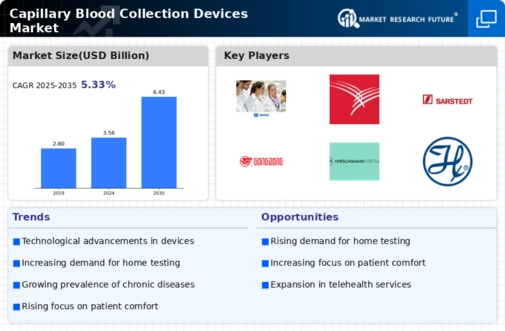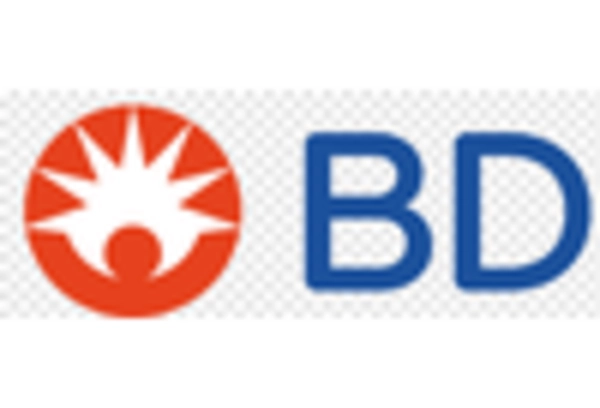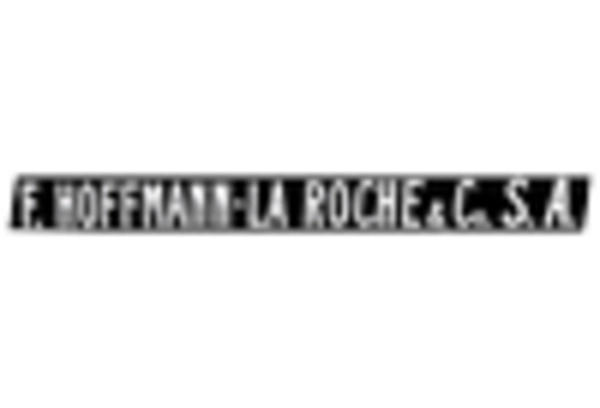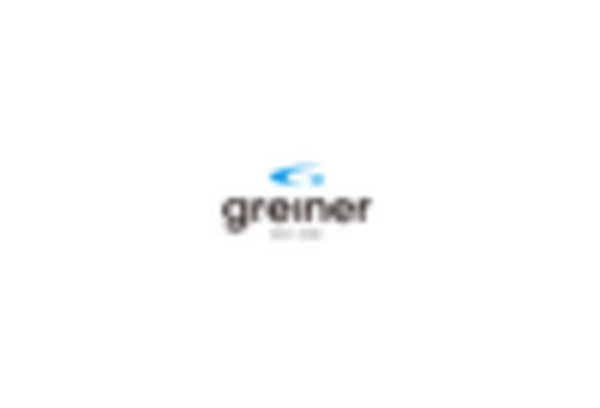-
EXECUTIVE SUMMARY
-
Market Overview
-
Key Findings
-
Market Segmentation
-
Competitive Landscape
-
Challenges and Opportunities
-
Future Outlook
-
MARKET INTRODUCTION
-
Definition
-
Scope of the study
- Research Objective
- Assumption
- Limitations
-
RESEARCH METHODOLOGY
-
Overview
-
Data Mining
-
Secondary Research
-
Primary Research
- Primary Interviews and Information Gathering Process
- Breakdown of Primary Respondents
-
Forecasting Model
-
Market Size Estimation
- Bottom-Up Approach
- Top-Down Approach
-
Data Triangulation
-
Validation
-
MARKET DYNAMICS
-
Overview
-
Drivers
-
Restraints
-
Opportunities
-
MARKET FACTOR ANALYSIS
-
Value chain Analysis
-
Porter's Five Forces Analysis
- Bargaining Power of Suppliers
- Bargaining Power of Buyers
- Threat of New Entrants
- Threat of Substitutes
- Intensity of Rivalry
-
COVID-19 Impact Analysis
- Market Impact Analysis
- Regional Impact
- Opportunity and Threat Analysis
-
CAPILLARY BLOOD COLLECTION DEVICES MARKET, BY DEVICE TYPE (USD BILLION)
-
Lancet Devices
-
Micro Collection Tubes
-
Blood Collection Kits
-
CAPILLARY BLOOD COLLECTION DEVICES MARKET, BY APPLICATION (USD BILLION)
-
Diabetes Screening
-
Cardiovascular Disease Diagnosis
-
Hematological Disorders
-
CAPILLARY BLOOD COLLECTION DEVICES MARKET, BY END USE (USD BILLION)
-
Hospitals
-
Diagnostic Laboratories
-
Home Healthcare
-
CAPILLARY BLOOD COLLECTION DEVICES MARKET, BY MATERIAL TYPE (USD BILLION)
-
Plastic
-
Glass
-
Silicone
-
CAPILLARY BLOOD COLLECTION DEVICES MARKET, BY REGIONAL (USD BILLION)
-
North America
- US
- Canada
-
Europe
- Germany
- UK
- France
- Russia
- Italy
- Spain
- Rest of Europe
-
APAC
- China
- India
- Japan
- South Korea
- Malaysia
- Thailand
- Indonesia
- Rest of APAC
-
South America
- Brazil
- Mexico
- Argentina
- Rest of South America
-
MEA
- GCC Countries
- South Africa
- Rest of MEA
-
COMPETITIVE LANDSCAPE
-
Overview
-
Competitive Analysis
-
Market share Analysis
-
Major Growth Strategy in the Capillary Blood Collection Devices Market
-
Competitive Benchmarking
-
Leading Players in Terms of Number of Developments in the Capillary Blood Collection Devices Market
-
Key developments and growth strategies
- New Product Launch/Service Deployment
- Merger & Acquisitions
- Joint Ventures
-
Major Players Financial Matrix
- Sales and Operating Income
- Major Players R&D Expenditure. 2023
-
COMPANY PROFILES
-
Nipro
- Financial Overview
- Products Offered
- Key Developments
- SWOT Analysis
- Key Strategies
-
Cardinal Health
- Financial Overview
- Products Offered
- Key Developments
- SWOT Analysis
- Key Strategies
-
Hema Care
- Financial Overview
- Products Offered
- Key Developments
- SWOT Analysis
- Key Strategies
-
Bluestone Global Tech
- Financial Overview
- Products Offered
- Key Developments
- SWOT Analysis
- Key Strategies
-
Sarstedt
- Financial Overview
- Products Offered
- Key Developments
- SWOT Analysis
- Key Strategies
-
Zhejiang Gongdong Medical Technology
- Financial Overview
- Products Offered
- Key Developments
- SWOT Analysis
- Key Strategies
-
BD
- Financial Overview
- Products Offered
- Key Developments
- SWOT Analysis
- Key Strategies
-
F.L. Medical
- Financial Overview
- Products Offered
- Key Developments
- SWOT Analysis
- Key Strategies
-
Hirschmann
- Financial Overview
- Products Offered
- Key Developments
- SWOT Analysis
- Key Strategies
-
Hamilton Company
- Financial Overview
- Products Offered
- Key Developments
- SWOT Analysis
- Key Strategies
-
Greiner BioOne
- Financial Overview
- Products Offered
- Key Developments
- SWOT Analysis
- Key Strategies
-
Pierta
- Financial Overview
- Products Offered
- Key Developments
- SWOT Analysis
- Key Strategies
-
Medtronic
- Financial Overview
- Products Offered
- Key Developments
- SWOT Analysis
- Key Strategies
-
Terumo
- Financial Overview
- Products Offered
- Key Developments
- SWOT Analysis
- Key Strategies
-
Drew Scientific
- Financial Overview
- Products Offered
- Key Developments
- SWOT Analysis
- Key Strategies
-
APPENDIX
-
References
-
Related Reports
-
LIST OF TABLES
-
LIST OF ASSUMPTIONS
-
NORTH AMERICA CAPILLARY BLOOD COLLECTION DEVICES MARKET SIZE ESTIMATES & FORECAST, BY DEVICE TYPE, 2019-2032 (USD BILLIONS)
-
NORTH AMERICA CAPILLARY BLOOD COLLECTION DEVICES MARKET SIZE ESTIMATES & FORECAST, BY APPLICATION, 2019-2032 (USD BILLIONS)
-
NORTH AMERICA CAPILLARY BLOOD COLLECTION DEVICES MARKET SIZE ESTIMATES & FORECAST, BY END USE, 2019-2032 (USD BILLIONS)
-
NORTH AMERICA CAPILLARY BLOOD COLLECTION DEVICES MARKET SIZE ESTIMATES & FORECAST, BY MATERIAL TYPE, 2019-2032 (USD BILLIONS)
-
NORTH AMERICA CAPILLARY BLOOD COLLECTION DEVICES MARKET SIZE ESTIMATES & FORECAST, BY REGIONAL, 2019-2032 (USD BILLIONS)
-
US CAPILLARY BLOOD COLLECTION DEVICES MARKET SIZE ESTIMATES & FORECAST, BY DEVICE TYPE, 2019-2032 (USD BILLIONS)
-
US CAPILLARY BLOOD COLLECTION DEVICES MARKET SIZE ESTIMATES & FORECAST, BY APPLICATION, 2019-2032 (USD BILLIONS)
-
US CAPILLARY BLOOD COLLECTION DEVICES MARKET SIZE ESTIMATES & FORECAST, BY END USE, 2019-2032 (USD BILLIONS)
-
US CAPILLARY BLOOD COLLECTION DEVICES MARKET SIZE ESTIMATES & FORECAST, BY MATERIAL TYPE, 2019-2032 (USD BILLIONS)
-
US CAPILLARY BLOOD COLLECTION DEVICES MARKET SIZE ESTIMATES & FORECAST, BY REGIONAL, 2019-2032 (USD BILLIONS)
-
CANADA CAPILLARY BLOOD COLLECTION DEVICES MARKET SIZE ESTIMATES & FORECAST, BY DEVICE TYPE, 2019-2032 (USD BILLIONS)
-
CANADA CAPILLARY BLOOD COLLECTION DEVICES MARKET SIZE ESTIMATES & FORECAST, BY APPLICATION, 2019-2032 (USD BILLIONS)
-
CANADA CAPILLARY BLOOD COLLECTION DEVICES MARKET SIZE ESTIMATES & FORECAST, BY END USE, 2019-2032 (USD BILLIONS)
-
CANADA CAPILLARY BLOOD COLLECTION DEVICES MARKET SIZE ESTIMATES & FORECAST, BY MATERIAL TYPE, 2019-2032 (USD BILLIONS)
-
CANADA CAPILLARY BLOOD COLLECTION DEVICES MARKET SIZE ESTIMATES & FORECAST, BY REGIONAL, 2019-2032 (USD BILLIONS)
-
EUROPE CAPILLARY BLOOD COLLECTION DEVICES MARKET SIZE ESTIMATES & FORECAST, BY DEVICE TYPE, 2019-2032 (USD BILLIONS)
-
EUROPE CAPILLARY BLOOD COLLECTION DEVICES MARKET SIZE ESTIMATES & FORECAST, BY APPLICATION, 2019-2032 (USD BILLIONS)
-
EUROPE CAPILLARY BLOOD COLLECTION DEVICES MARKET SIZE ESTIMATES & FORECAST, BY END USE, 2019-2032 (USD BILLIONS)
-
EUROPE CAPILLARY BLOOD COLLECTION DEVICES MARKET SIZE ESTIMATES & FORECAST, BY MATERIAL TYPE, 2019-2032 (USD BILLIONS)
-
EUROPE CAPILLARY BLOOD COLLECTION DEVICES MARKET SIZE ESTIMATES & FORECAST, BY REGIONAL, 2019-2032 (USD BILLIONS)
-
GERMANY CAPILLARY BLOOD COLLECTION DEVICES MARKET SIZE ESTIMATES & FORECAST, BY DEVICE TYPE, 2019-2032 (USD BILLIONS)
-
GERMANY CAPILLARY BLOOD COLLECTION DEVICES MARKET SIZE ESTIMATES & FORECAST, BY APPLICATION, 2019-2032 (USD BILLIONS)
-
GERMANY CAPILLARY BLOOD COLLECTION DEVICES MARKET SIZE ESTIMATES & FORECAST, BY END USE, 2019-2032 (USD BILLIONS)
-
GERMANY CAPILLARY BLOOD COLLECTION DEVICES MARKET SIZE ESTIMATES & FORECAST, BY MATERIAL TYPE, 2019-2032 (USD BILLIONS)
-
GERMANY CAPILLARY BLOOD COLLECTION DEVICES MARKET SIZE ESTIMATES & FORECAST, BY REGIONAL, 2019-2032 (USD BILLIONS)
-
UK CAPILLARY BLOOD COLLECTION DEVICES MARKET SIZE ESTIMATES & FORECAST, BY DEVICE TYPE, 2019-2032 (USD BILLIONS)
-
UK CAPILLARY BLOOD COLLECTION DEVICES MARKET SIZE ESTIMATES & FORECAST, BY APPLICATION, 2019-2032 (USD BILLIONS)
-
UK CAPILLARY BLOOD COLLECTION DEVICES MARKET SIZE ESTIMATES & FORECAST, BY END USE, 2019-2032 (USD BILLIONS)
-
UK CAPILLARY BLOOD COLLECTION DEVICES MARKET SIZE ESTIMATES & FORECAST, BY MATERIAL TYPE, 2019-2032 (USD BILLIONS)
-
UK CAPILLARY BLOOD COLLECTION DEVICES MARKET SIZE ESTIMATES & FORECAST, BY REGIONAL, 2019-2032 (USD BILLIONS)
-
FRANCE CAPILLARY BLOOD COLLECTION DEVICES MARKET SIZE ESTIMATES & FORECAST, BY DEVICE TYPE, 2019-2032 (USD BILLIONS)
-
FRANCE CAPILLARY BLOOD COLLECTION DEVICES MARKET SIZE ESTIMATES & FORECAST, BY APPLICATION, 2019-2032 (USD BILLIONS)
-
FRANCE CAPILLARY BLOOD COLLECTION DEVICES MARKET SIZE ESTIMATES & FORECAST, BY END USE, 2019-2032 (USD BILLIONS)
-
FRANCE CAPILLARY BLOOD COLLECTION DEVICES MARKET SIZE ESTIMATES & FORECAST, BY MATERIAL TYPE, 2019-2032 (USD BILLIONS)
-
FRANCE CAPILLARY BLOOD COLLECTION DEVICES MARKET SIZE ESTIMATES & FORECAST, BY REGIONAL, 2019-2032 (USD BILLIONS)
-
RUSSIA CAPILLARY BLOOD COLLECTION DEVICES MARKET SIZE ESTIMATES & FORECAST, BY DEVICE TYPE, 2019-2032 (USD BILLIONS)
-
RUSSIA CAPILLARY BLOOD COLLECTION DEVICES MARKET SIZE ESTIMATES & FORECAST, BY APPLICATION, 2019-2032 (USD BILLIONS)
-
RUSSIA CAPILLARY BLOOD COLLECTION DEVICES MARKET SIZE ESTIMATES & FORECAST, BY END USE, 2019-2032 (USD BILLIONS)
-
RUSSIA CAPILLARY BLOOD COLLECTION DEVICES MARKET SIZE ESTIMATES & FORECAST, BY MATERIAL TYPE, 2019-2032 (USD BILLIONS)
-
RUSSIA CAPILLARY BLOOD COLLECTION DEVICES MARKET SIZE ESTIMATES & FORECAST, BY REGIONAL, 2019-2032 (USD BILLIONS)
-
ITALY CAPILLARY BLOOD COLLECTION DEVICES MARKET SIZE ESTIMATES & FORECAST, BY DEVICE TYPE, 2019-2032 (USD BILLIONS)
-
ITALY CAPILLARY BLOOD COLLECTION DEVICES MARKET SIZE ESTIMATES & FORECAST, BY APPLICATION, 2019-2032 (USD BILLIONS)
-
ITALY CAPILLARY BLOOD COLLECTION DEVICES MARKET SIZE ESTIMATES & FORECAST, BY END USE, 2019-2032 (USD BILLIONS)
-
ITALY CAPILLARY BLOOD COLLECTION DEVICES MARKET SIZE ESTIMATES & FORECAST, BY MATERIAL TYPE, 2019-2032 (USD BILLIONS)
-
ITALY CAPILLARY BLOOD COLLECTION DEVICES MARKET SIZE ESTIMATES & FORECAST, BY REGIONAL, 2019-2032 (USD BILLIONS)
-
SPAIN CAPILLARY BLOOD COLLECTION DEVICES MARKET SIZE ESTIMATES & FORECAST, BY DEVICE TYPE, 2019-2032 (USD BILLIONS)
-
SPAIN CAPILLARY BLOOD COLLECTION DEVICES MARKET SIZE ESTIMATES & FORECAST, BY APPLICATION, 2019-2032 (USD BILLIONS)
-
SPAIN CAPILLARY BLOOD COLLECTION DEVICES MARKET SIZE ESTIMATES & FORECAST, BY END USE, 2019-2032 (USD BILLIONS)
-
SPAIN CAPILLARY BLOOD COLLECTION DEVICES MARKET SIZE ESTIMATES & FORECAST, BY MATERIAL TYPE, 2019-2032 (USD BILLIONS)
-
SPAIN CAPILLARY BLOOD COLLECTION DEVICES MARKET SIZE ESTIMATES & FORECAST, BY REGIONAL, 2019-2032 (USD BILLIONS)
-
REST OF EUROPE CAPILLARY BLOOD COLLECTION DEVICES MARKET SIZE ESTIMATES & FORECAST, BY DEVICE TYPE, 2019-2032 (USD BILLIONS)
-
REST OF EUROPE CAPILLARY BLOOD COLLECTION DEVICES MARKET SIZE ESTIMATES & FORECAST, BY APPLICATION, 2019-2032 (USD BILLIONS)
-
REST OF EUROPE CAPILLARY BLOOD COLLECTION DEVICES MARKET SIZE ESTIMATES & FORECAST, BY END USE, 2019-2032 (USD BILLIONS)
-
REST OF EUROPE CAPILLARY BLOOD COLLECTION DEVICES MARKET SIZE ESTIMATES & FORECAST, BY MATERIAL TYPE, 2019-2032 (USD BILLIONS)
-
REST OF EUROPE CAPILLARY BLOOD COLLECTION DEVICES MARKET SIZE ESTIMATES & FORECAST, BY REGIONAL, 2019-2032 (USD BILLIONS)
-
APAC CAPILLARY BLOOD COLLECTION DEVICES MARKET SIZE ESTIMATES & FORECAST, BY DEVICE TYPE, 2019-2032 (USD BILLIONS)
-
APAC CAPILLARY BLOOD COLLECTION DEVICES MARKET SIZE ESTIMATES & FORECAST, BY APPLICATION, 2019-2032 (USD BILLIONS)
-
APAC CAPILLARY BLOOD COLLECTION DEVICES MARKET SIZE ESTIMATES & FORECAST, BY END USE, 2019-2032 (USD BILLIONS)
-
APAC CAPILLARY BLOOD COLLECTION DEVICES MARKET SIZE ESTIMATES & FORECAST, BY MATERIAL TYPE, 2019-2032 (USD BILLIONS)
-
APAC CAPILLARY BLOOD COLLECTION DEVICES MARKET SIZE ESTIMATES & FORECAST, BY REGIONAL, 2019-2032 (USD BILLIONS)
-
CHINA CAPILLARY BLOOD COLLECTION DEVICES MARKET SIZE ESTIMATES & FORECAST, BY DEVICE TYPE, 2019-2032 (USD BILLIONS)
-
CHINA CAPILLARY BLOOD COLLECTION DEVICES MARKET SIZE ESTIMATES & FORECAST, BY APPLICATION, 2019-2032 (USD BILLIONS)
-
CHINA CAPILLARY BLOOD COLLECTION DEVICES MARKET SIZE ESTIMATES & FORECAST, BY END USE, 2019-2032 (USD BILLIONS)
-
CHINA CAPILLARY BLOOD COLLECTION DEVICES MARKET SIZE ESTIMATES & FORECAST, BY MATERIAL TYPE, 2019-2032 (USD BILLIONS)
-
CHINA CAPILLARY BLOOD COLLECTION DEVICES MARKET SIZE ESTIMATES & FORECAST, BY REGIONAL, 2019-2032 (USD BILLIONS)
-
INDIA CAPILLARY BLOOD COLLECTION DEVICES MARKET SIZE ESTIMATES & FORECAST, BY DEVICE TYPE, 2019-2032 (USD BILLIONS)
-
INDIA CAPILLARY BLOOD COLLECTION DEVICES MARKET SIZE ESTIMATES & FORECAST, BY APPLICATION, 2019-2032 (USD BILLIONS)
-
INDIA CAPILLARY BLOOD COLLECTION DEVICES MARKET SIZE ESTIMATES & FORECAST, BY END USE, 2019-2032 (USD BILLIONS)
-
INDIA CAPILLARY BLOOD COLLECTION DEVICES MARKET SIZE ESTIMATES & FORECAST, BY MATERIAL TYPE, 2019-2032 (USD BILLIONS)
-
INDIA CAPILLARY BLOOD COLLECTION DEVICES MARKET SIZE ESTIMATES & FORECAST, BY REGIONAL, 2019-2032 (USD BILLIONS)
-
JAPAN CAPILLARY BLOOD COLLECTION DEVICES MARKET SIZE ESTIMATES & FORECAST, BY DEVICE TYPE, 2019-2032 (USD BILLIONS)
-
JAPAN CAPILLARY BLOOD COLLECTION DEVICES MARKET SIZE ESTIMATES & FORECAST, BY APPLICATION, 2019-2032 (USD BILLIONS)
-
JAPAN CAPILLARY BLOOD COLLECTION DEVICES MARKET SIZE ESTIMATES & FORECAST, BY END USE, 2019-2032 (USD BILLIONS)
-
JAPAN CAPILLARY BLOOD COLLECTION DEVICES MARKET SIZE ESTIMATES & FORECAST, BY MATERIAL TYPE, 2019-2032 (USD BILLIONS)
-
JAPAN CAPILLARY BLOOD COLLECTION DEVICES MARKET SIZE ESTIMATES & FORECAST, BY REGIONAL, 2019-2032 (USD BILLIONS)
-
SOUTH KOREA CAPILLARY BLOOD COLLECTION DEVICES MARKET SIZE ESTIMATES & FORECAST, BY DEVICE TYPE, 2019-2032 (USD BILLIONS)
-
SOUTH KOREA CAPILLARY BLOOD COLLECTION DEVICES MARKET SIZE ESTIMATES & FORECAST, BY APPLICATION, 2019-2032 (USD BILLIONS)
-
SOUTH KOREA CAPILLARY BLOOD COLLECTION DEVICES MARKET SIZE ESTIMATES & FORECAST, BY END USE, 2019-2032 (USD BILLIONS)
-
SOUTH KOREA CAPILLARY BLOOD COLLECTION DEVICES MARKET SIZE ESTIMATES & FORECAST, BY MATERIAL TYPE, 2019-2032 (USD BILLIONS)
-
SOUTH KOREA CAPILLARY BLOOD COLLECTION DEVICES MARKET SIZE ESTIMATES & FORECAST, BY REGIONAL, 2019-2032 (USD BILLIONS)
-
MALAYSIA CAPILLARY BLOOD COLLECTION DEVICES MARKET SIZE ESTIMATES & FORECAST, BY DEVICE TYPE, 2019-2032 (USD BILLIONS)
-
MALAYSIA CAPILLARY BLOOD COLLECTION DEVICES MARKET SIZE ESTIMATES & FORECAST, BY APPLICATION, 2019-2032 (USD BILLIONS)
-
MALAYSIA CAPILLARY BLOOD COLLECTION DEVICES MARKET SIZE ESTIMATES & FORECAST, BY END USE, 2019-2032 (USD BILLIONS)
-
MALAYSIA CAPILLARY BLOOD COLLECTION DEVICES MARKET SIZE ESTIMATES & FORECAST, BY MATERIAL TYPE, 2019-2032 (USD BILLIONS)
-
MALAYSIA CAPILLARY BLOOD COLLECTION DEVICES MARKET SIZE ESTIMATES & FORECAST, BY REGIONAL, 2019-2032 (USD BILLIONS)
-
THAILAND CAPILLARY BLOOD COLLECTION DEVICES MARKET SIZE ESTIMATES & FORECAST, BY DEVICE TYPE, 2019-2032 (USD BILLIONS)
-
THAILAND CAPILLARY BLOOD COLLECTION DEVICES MARKET SIZE ESTIMATES & FORECAST, BY APPLICATION, 2019-2032 (USD BILLIONS)
-
THAILAND CAPILLARY BLOOD COLLECTION DEVICES MARKET SIZE ESTIMATES & FORECAST, BY END USE, 2019-2032 (USD BILLIONS)
-
THAILAND CAPILLARY BLOOD COLLECTION DEVICES MARKET SIZE ESTIMATES & FORECAST, BY MATERIAL TYPE, 2019-2032 (USD BILLIONS)
-
THAILAND CAPILLARY BLOOD COLLECTION DEVICES MARKET SIZE ESTIMATES & FORECAST, BY REGIONAL, 2019-2032 (USD BILLIONS)
-
INDONESIA CAPILLARY BLOOD COLLECTION DEVICES MARKET SIZE ESTIMATES & FORECAST, BY DEVICE TYPE, 2019-2032 (USD BILLIONS)
-
INDONESIA CAPILLARY BLOOD COLLECTION DEVICES MARKET SIZE ESTIMATES & FORECAST, BY APPLICATION, 2019-2032 (USD BILLIONS)
-
INDONESIA CAPILLARY BLOOD COLLECTION DEVICES MARKET SIZE ESTIMATES & FORECAST, BY END USE, 2019-2032 (USD BILLIONS)
-
INDONESIA CAPILLARY BLOOD COLLECTION DEVICES MARKET SIZE ESTIMATES & FORECAST, BY MATERIAL TYPE, 2019-2032 (USD BILLIONS)
-
INDONESIA CAPILLARY BLOOD COLLECTION DEVICES MARKET SIZE ESTIMATES & FORECAST, BY REGIONAL, 2019-2032 (USD BILLIONS)
-
REST OF APAC CAPILLARY BLOOD COLLECTION DEVICES MARKET SIZE ESTIMATES & FORECAST, BY DEVICE TYPE, 2019-2032 (USD BILLIONS)
-
REST OF APAC CAPILLARY BLOOD COLLECTION DEVICES MARKET SIZE ESTIMATES & FORECAST, BY APPLICATION, 2019-2032 (USD BILLIONS)
-
REST OF APAC CAPILLARY BLOOD COLLECTION DEVICES MARKET SIZE ESTIMATES & FORECAST, BY END USE, 2019-2032 (USD BILLIONS)
-
REST OF APAC CAPILLARY BLOOD COLLECTION DEVICES MARKET SIZE ESTIMATES & FORECAST, BY MATERIAL TYPE, 2019-2032 (USD BILLIONS)
-
REST OF APAC CAPILLARY BLOOD COLLECTION DEVICES MARKET SIZE ESTIMATES & FORECAST, BY REGIONAL, 2019-2032 (USD BILLIONS)
-
SOUTH AMERICA CAPILLARY BLOOD COLLECTION DEVICES MARKET SIZE ESTIMATES & FORECAST, BY DEVICE TYPE, 2019-2032 (USD BILLIONS)
-
SOUTH AMERICA CAPILLARY BLOOD COLLECTION DEVICES MARKET SIZE ESTIMATES & FORECAST, BY APPLICATION, 2019-2032 (USD BILLIONS)
-
SOUTH AMERICA CAPILLARY BLOOD COLLECTION DEVICES MARKET SIZE ESTIMATES & FORECAST, BY END USE, 2019-2032 (USD BILLIONS)
-
SOUTH AMERICA CAPILLARY BLOOD COLLECTION DEVICES MARKET SIZE ESTIMATES & FORECAST, BY MATERIAL TYPE, 2019-2032 (USD BILLIONS)
-
SOUTH AMERICA CAPILLARY BLOOD COLLECTION DEVICES MARKET SIZE ESTIMATES & FORECAST, BY REGIONAL, 2019-2032 (USD BILLIONS)
-
BRAZIL CAPILLARY BLOOD COLLECTION DEVICES MARKET SIZE ESTIMATES & FORECAST, BY DEVICE TYPE, 2019-2032 (USD BILLIONS)
-
BRAZIL CAPILLARY BLOOD COLLECTION DEVICES MARKET SIZE ESTIMATES & FORECAST, BY APPLICATION, 2019-2032 (USD BILLIONS)
-
BRAZIL CAPILLARY BLOOD COLLECTION DEVICES MARKET SIZE ESTIMATES & FORECAST, BY END USE, 2019-2032 (USD BILLIONS)
-
BRAZIL CAPILLARY BLOOD COLLECTION DEVICES MARKET SIZE ESTIMATES & FORECAST, BY MATERIAL TYPE, 2019-2032 (USD BILLIONS)
-
BRAZIL CAPILLARY BLOOD COLLECTION DEVICES MARKET SIZE ESTIMATES & FORECAST, BY REGIONAL, 2019-2032 (USD BILLIONS)
-
MEXICO CAPILLARY BLOOD COLLECTION DEVICES MARKET SIZE ESTIMATES & FORECAST, BY DEVICE TYPE, 2019-2032 (USD BILLIONS)
-
MEXICO CAPILLARY BLOOD COLLECTION DEVICES MARKET SIZE ESTIMATES & FORECAST, BY APPLICATION, 2019-2032 (USD BILLIONS)
-
MEXICO CAPILLARY BLOOD COLLECTION DEVICES MARKET SIZE ESTIMATES & FORECAST, BY END USE, 2019-2032 (USD BILLIONS)
-
MEXICO CAPILLARY BLOOD COLLECTION DEVICES MARKET SIZE ESTIMATES & FORECAST, BY MATERIAL TYPE, 2019-2032 (USD BILLIONS)
-
MEXICO CAPILLARY BLOOD COLLECTION DEVICES MARKET SIZE ESTIMATES & FORECAST, BY REGIONAL, 2019-2032 (USD BILLIONS)
-
ARGENTINA CAPILLARY BLOOD COLLECTION DEVICES MARKET SIZE ESTIMATES & FORECAST, BY DEVICE TYPE, 2019-2032 (USD BILLIONS)
-
ARGENTINA CAPILLARY BLOOD COLLECTION DEVICES MARKET SIZE ESTIMATES & FORECAST, BY APPLICATION, 2019-2032 (USD BILLIONS)
-
ARGENTINA CAPILLARY BLOOD COLLECTION DEVICES MARKET SIZE ESTIMATES & FORECAST, BY END USE, 2019-2032 (USD BILLIONS)
-
ARGENTINA CAPILLARY BLOOD COLLECTION DEVICES MARKET SIZE ESTIMATES & FORECAST, BY MATERIAL TYPE, 2019-2032 (USD BILLIONS)
-
ARGENTINA CAPILLARY BLOOD COLLECTION DEVICES MARKET SIZE ESTIMATES & FORECAST, BY REGIONAL, 2019-2032 (USD BILLIONS)
-
REST OF SOUTH AMERICA CAPILLARY BLOOD COLLECTION DEVICES MARKET SIZE ESTIMATES & FORECAST, BY DEVICE TYPE, 2019-2032 (USD BILLIONS)
-
REST OF SOUTH AMERICA CAPILLARY BLOOD COLLECTION DEVICES MARKET SIZE ESTIMATES & FORECAST, BY APPLICATION, 2019-2032 (USD BILLIONS)
-
REST OF SOUTH AMERICA CAPILLARY BLOOD COLLECTION DEVICES MARKET SIZE ESTIMATES & FORECAST, BY END USE, 2019-2032 (USD BILLIONS)
-
REST OF SOUTH AMERICA CAPILLARY BLOOD COLLECTION DEVICES MARKET SIZE ESTIMATES & FORECAST, BY MATERIAL TYPE, 2019-2032 (USD BILLIONS)
-
REST OF SOUTH AMERICA CAPILLARY BLOOD COLLECTION DEVICES MARKET SIZE ESTIMATES & FORECAST, BY REGIONAL, 2019-2032 (USD BILLIONS)
-
MEA CAPILLARY BLOOD COLLECTION DEVICES MARKET SIZE ESTIMATES & FORECAST, BY DEVICE TYPE, 2019-2032 (USD BILLIONS)
-
MEA CAPILLARY BLOOD COLLECTION DEVICES MARKET SIZE ESTIMATES & FORECAST, BY APPLICATION, 2019-2032 (USD BILLIONS)
-
MEA CAPILLARY BLOOD COLLECTION DEVICES MARKET SIZE ESTIMATES & FORECAST, BY END USE, 2019-2032 (USD BILLIONS)
-
MEA CAPILLARY BLOOD COLLECTION DEVICES MARKET SIZE ESTIMATES & FORECAST, BY MATERIAL TYPE, 2019-2032 (USD BILLIONS)
-
MEA CAPILLARY BLOOD COLLECTION DEVICES MARKET SIZE ESTIMATES & FORECAST, BY REGIONAL, 2019-2032 (USD BILLIONS)
-
GCC COUNTRIES CAPILLARY BLOOD COLLECTION DEVICES MARKET SIZE ESTIMATES & FORECAST, BY DEVICE TYPE, 2019-2032 (USD BILLIONS)
-
GCC COUNTRIES CAPILLARY BLOOD COLLECTION DEVICES MARKET SIZE ESTIMATES & FORECAST, BY APPLICATION, 2019-2032 (USD BILLIONS)
-
GCC COUNTRIES CAPILLARY BLOOD COLLECTION DEVICES MARKET SIZE ESTIMATES & FORECAST, BY END USE, 2019-2032 (USD BILLIONS)
-
GCC COUNTRIES CAPILLARY BLOOD COLLECTION DEVICES MARKET SIZE ESTIMATES & FORECAST, BY MATERIAL TYPE, 2019-2032 (USD BILLIONS)
-
GCC COUNTRIES CAPILLARY BLOOD COLLECTION DEVICES MARKET SIZE ESTIMATES & FORECAST, BY REGIONAL, 2019-2032 (USD BILLIONS)
-
SOUTH AFRICA CAPILLARY BLOOD COLLECTION DEVICES MARKET SIZE ESTIMATES & FORECAST, BY DEVICE TYPE, 2019-2032 (USD BILLIONS)
-
SOUTH AFRICA CAPILLARY BLOOD COLLECTION DEVICES MARKET SIZE ESTIMATES & FORECAST, BY APPLICATION, 2019-2032 (USD BILLIONS)
-
SOUTH AFRICA CAPILLARY BLOOD COLLECTION DEVICES MARKET SIZE ESTIMATES & FORECAST, BY END USE, 2019-2032 (USD BILLIONS)
-
SOUTH AFRICA CAPILLARY BLOOD COLLECTION DEVICES MARKET SIZE ESTIMATES & FORECAST, BY MATERIAL TYPE, 2019-2032 (USD BILLIONS)
-
SOUTH AFRICA CAPILLARY BLOOD COLLECTION DEVICES MARKET SIZE ESTIMATES & FORECAST, BY REGIONAL, 2019-2032 (USD BILLIONS)
-
REST OF MEA CAPILLARY BLOOD COLLECTION DEVICES MARKET SIZE ESTIMATES & FORECAST, BY DEVICE TYPE, 2019-2032 (USD BILLIONS)
-
REST OF MEA CAPILLARY BLOOD COLLECTION DEVICES MARKET SIZE ESTIMATES & FORECAST, BY APPLICATION, 2019-2032 (USD BILLIONS)
-
REST OF MEA CAPILLARY BLOOD COLLECTION DEVICES MARKET SIZE ESTIMATES & FORECAST, BY END USE, 2019-2032 (USD BILLIONS)
-
REST OF MEA CAPILLARY BLOOD COLLECTION DEVICES MARKET SIZE ESTIMATES & FORECAST, BY MATERIAL TYPE, 2019-2032 (USD BILLIONS)
-
REST OF MEA CAPILLARY BLOOD COLLECTION DEVICES MARKET SIZE ESTIMATES & FORECAST, BY REGIONAL, 2019-2032 (USD BILLIONS)
-
PRODUCT LAUNCH/PRODUCT DEVELOPMENT/APPROVAL
-
ACQUISITION/PARTNERSHIP
-
LIST OF FIGURES
-
MARKET SYNOPSIS
-
NORTH AMERICA CAPILLARY BLOOD COLLECTION DEVICES MARKET ANALYSIS
-
US CAPILLARY BLOOD COLLECTION DEVICES MARKET ANALYSIS BY DEVICE TYPE
-
US CAPILLARY BLOOD COLLECTION DEVICES MARKET ANALYSIS BY APPLICATION
-
US CAPILLARY BLOOD COLLECTION DEVICES MARKET ANALYSIS BY END USE
-
US CAPILLARY BLOOD COLLECTION DEVICES MARKET ANALYSIS BY MATERIAL TYPE
-
US CAPILLARY BLOOD COLLECTION DEVICES MARKET ANALYSIS BY REGIONAL
-
CANADA CAPILLARY BLOOD COLLECTION DEVICES MARKET ANALYSIS BY DEVICE TYPE
-
CANADA CAPILLARY BLOOD COLLECTION DEVICES MARKET ANALYSIS BY APPLICATION
-
CANADA CAPILLARY BLOOD COLLECTION DEVICES MARKET ANALYSIS BY END USE
-
CANADA CAPILLARY BLOOD COLLECTION DEVICES MARKET ANALYSIS BY MATERIAL TYPE
-
CANADA CAPILLARY BLOOD COLLECTION DEVICES MARKET ANALYSIS BY REGIONAL
-
EUROPE CAPILLARY BLOOD COLLECTION DEVICES MARKET ANALYSIS
-
GERMANY CAPILLARY BLOOD COLLECTION DEVICES MARKET ANALYSIS BY DEVICE TYPE
-
GERMANY CAPILLARY BLOOD COLLECTION DEVICES MARKET ANALYSIS BY APPLICATION
-
GERMANY CAPILLARY BLOOD COLLECTION DEVICES MARKET ANALYSIS BY END USE
-
GERMANY CAPILLARY BLOOD COLLECTION DEVICES MARKET ANALYSIS BY MATERIAL TYPE
-
GERMANY CAPILLARY BLOOD COLLECTION DEVICES MARKET ANALYSIS BY REGIONAL
-
UK CAPILLARY BLOOD COLLECTION DEVICES MARKET ANALYSIS BY DEVICE TYPE
-
UK CAPILLARY BLOOD COLLECTION DEVICES MARKET ANALYSIS BY APPLICATION
-
UK CAPILLARY BLOOD COLLECTION DEVICES MARKET ANALYSIS BY END USE
-
UK CAPILLARY BLOOD COLLECTION DEVICES MARKET ANALYSIS BY MATERIAL TYPE
-
UK CAPILLARY BLOOD COLLECTION DEVICES MARKET ANALYSIS BY REGIONAL
-
FRANCE CAPILLARY BLOOD COLLECTION DEVICES MARKET ANALYSIS BY DEVICE TYPE
-
FRANCE CAPILLARY BLOOD COLLECTION DEVICES MARKET ANALYSIS BY APPLICATION
-
FRANCE CAPILLARY BLOOD COLLECTION DEVICES MARKET ANALYSIS BY END USE
-
FRANCE CAPILLARY BLOOD COLLECTION DEVICES MARKET ANALYSIS BY MATERIAL TYPE
-
FRANCE CAPILLARY BLOOD COLLECTION DEVICES MARKET ANALYSIS BY REGIONAL
-
RUSSIA CAPILLARY BLOOD COLLECTION DEVICES MARKET ANALYSIS BY DEVICE TYPE
-
RUSSIA CAPILLARY BLOOD COLLECTION DEVICES MARKET ANALYSIS BY APPLICATION
-
RUSSIA CAPILLARY BLOOD COLLECTION DEVICES MARKET ANALYSIS BY END USE
-
RUSSIA CAPILLARY BLOOD COLLECTION DEVICES MARKET ANALYSIS BY MATERIAL TYPE
-
RUSSIA CAPILLARY BLOOD COLLECTION DEVICES MARKET ANALYSIS BY REGIONAL
-
ITALY CAPILLARY BLOOD COLLECTION DEVICES MARKET ANALYSIS BY DEVICE TYPE
-
ITALY CAPILLARY BLOOD COLLECTION DEVICES MARKET ANALYSIS BY APPLICATION
-
ITALY CAPILLARY BLOOD COLLECTION DEVICES MARKET ANALYSIS BY END USE
-
ITALY CAPILLARY BLOOD COLLECTION DEVICES MARKET ANALYSIS BY MATERIAL TYPE
-
ITALY CAPILLARY BLOOD COLLECTION DEVICES MARKET ANALYSIS BY REGIONAL
-
SPAIN CAPILLARY BLOOD COLLECTION DEVICES MARKET ANALYSIS BY DEVICE TYPE
-
SPAIN CAPILLARY BLOOD COLLECTION DEVICES MARKET ANALYSIS BY APPLICATION
-
SPAIN CAPILLARY BLOOD COLLECTION DEVICES MARKET ANALYSIS BY END USE
-
SPAIN CAPILLARY BLOOD COLLECTION DEVICES MARKET ANALYSIS BY MATERIAL TYPE
-
SPAIN CAPILLARY BLOOD COLLECTION DEVICES MARKET ANALYSIS BY REGIONAL
-
REST OF EUROPE CAPILLARY BLOOD COLLECTION DEVICES MARKET ANALYSIS BY DEVICE TYPE
-
REST OF EUROPE CAPILLARY BLOOD COLLECTION DEVICES MARKET ANALYSIS BY APPLICATION
-
REST OF EUROPE CAPILLARY BLOOD COLLECTION DEVICES MARKET ANALYSIS BY END USE
-
REST OF EUROPE CAPILLARY BLOOD COLLECTION DEVICES MARKET ANALYSIS BY MATERIAL TYPE
-
REST OF EUROPE CAPILLARY BLOOD COLLECTION DEVICES MARKET ANALYSIS BY REGIONAL
-
APAC CAPILLARY BLOOD COLLECTION DEVICES MARKET ANALYSIS
-
CHINA CAPILLARY BLOOD COLLECTION DEVICES MARKET ANALYSIS BY DEVICE TYPE
-
CHINA CAPILLARY BLOOD COLLECTION DEVICES MARKET ANALYSIS BY APPLICATION
-
CHINA CAPILLARY BLOOD COLLECTION DEVICES MARKET ANALYSIS BY END USE
-
CHINA CAPILLARY BLOOD COLLECTION DEVICES MARKET ANALYSIS BY MATERIAL TYPE
-
CHINA CAPILLARY BLOOD COLLECTION DEVICES MARKET ANALYSIS BY REGIONAL
-
INDIA CAPILLARY BLOOD COLLECTION DEVICES MARKET ANALYSIS BY DEVICE TYPE
-
INDIA CAPILLARY BLOOD COLLECTION DEVICES MARKET ANALYSIS BY APPLICATION
-
INDIA CAPILLARY BLOOD COLLECTION DEVICES MARKET ANALYSIS BY END USE
-
INDIA CAPILLARY BLOOD COLLECTION DEVICES MARKET ANALYSIS BY MATERIAL TYPE
-
INDIA CAPILLARY BLOOD COLLECTION DEVICES MARKET ANALYSIS BY REGIONAL
-
JAPAN CAPILLARY BLOOD COLLECTION DEVICES MARKET ANALYSIS BY DEVICE TYPE
-
JAPAN CAPILLARY BLOOD COLLECTION DEVICES MARKET ANALYSIS BY APPLICATION
-
JAPAN CAPILLARY BLOOD COLLECTION DEVICES MARKET ANALYSIS BY END USE
-
JAPAN CAPILLARY BLOOD COLLECTION DEVICES MARKET ANALYSIS BY MATERIAL TYPE
-
JAPAN CAPILLARY BLOOD COLLECTION DEVICES MARKET ANALYSIS BY REGIONAL
-
SOUTH KOREA CAPILLARY BLOOD COLLECTION DEVICES MARKET ANALYSIS BY DEVICE TYPE
-
SOUTH KOREA CAPILLARY BLOOD COLLECTION DEVICES MARKET ANALYSIS BY APPLICATION
-
SOUTH KOREA CAPILLARY BLOOD COLLECTION DEVICES MARKET ANALYSIS BY END USE
-
SOUTH KOREA CAPILLARY BLOOD COLLECTION DEVICES MARKET ANALYSIS BY MATERIAL TYPE
-
SOUTH KOREA CAPILLARY BLOOD COLLECTION DEVICES MARKET ANALYSIS BY REGIONAL
-
MALAYSIA CAPILLARY BLOOD COLLECTION DEVICES MARKET ANALYSIS BY DEVICE TYPE
-
MALAYSIA CAPILLARY BLOOD COLLECTION DEVICES MARKET ANALYSIS BY APPLICATION
-
MALAYSIA CAPILLARY BLOOD COLLECTION DEVICES MARKET ANALYSIS









Leave a Comment